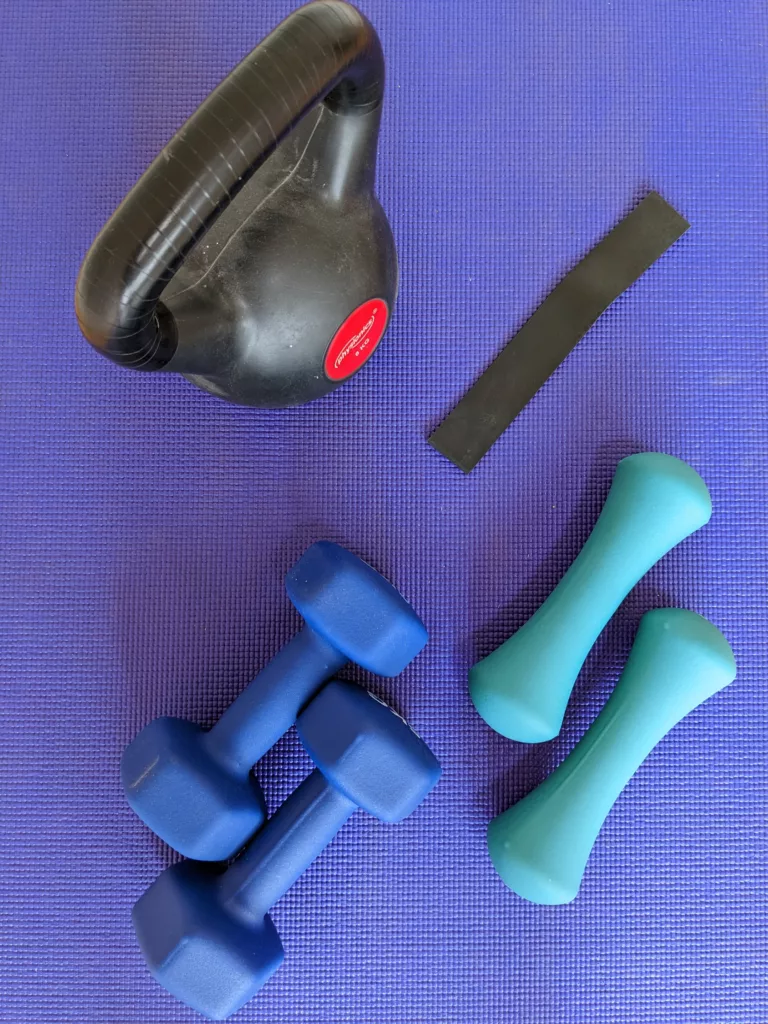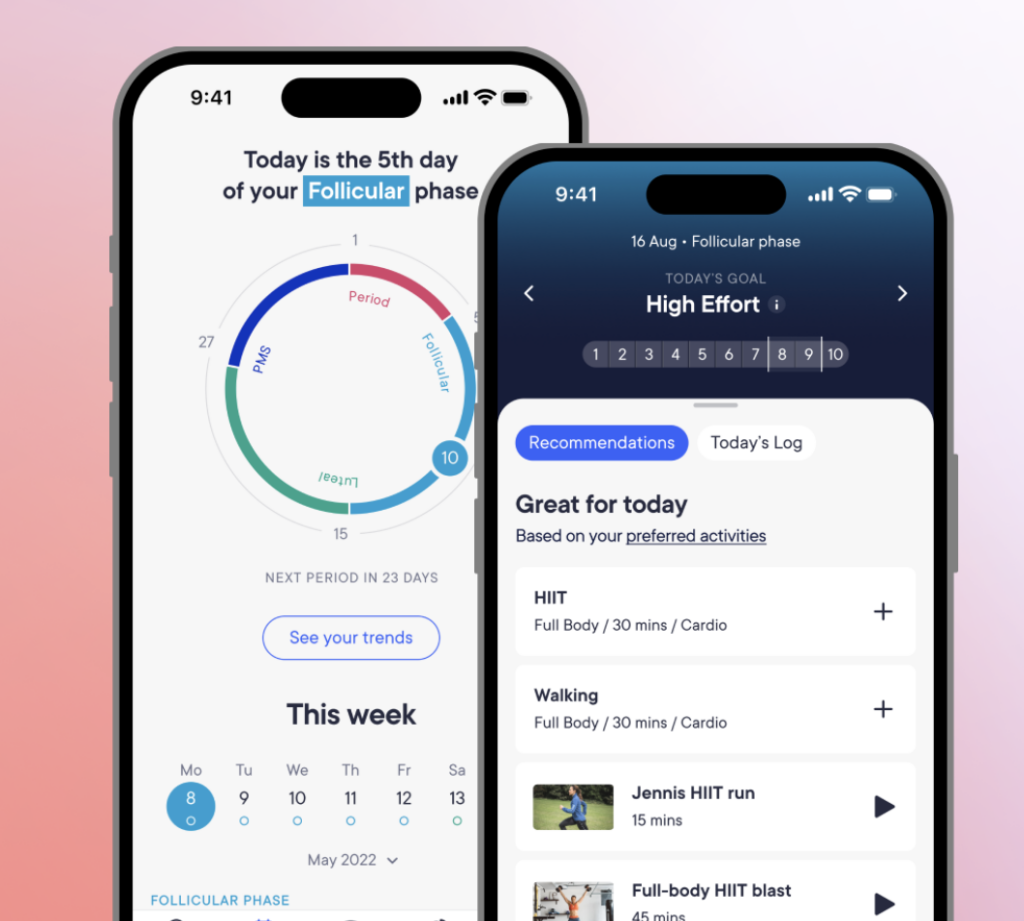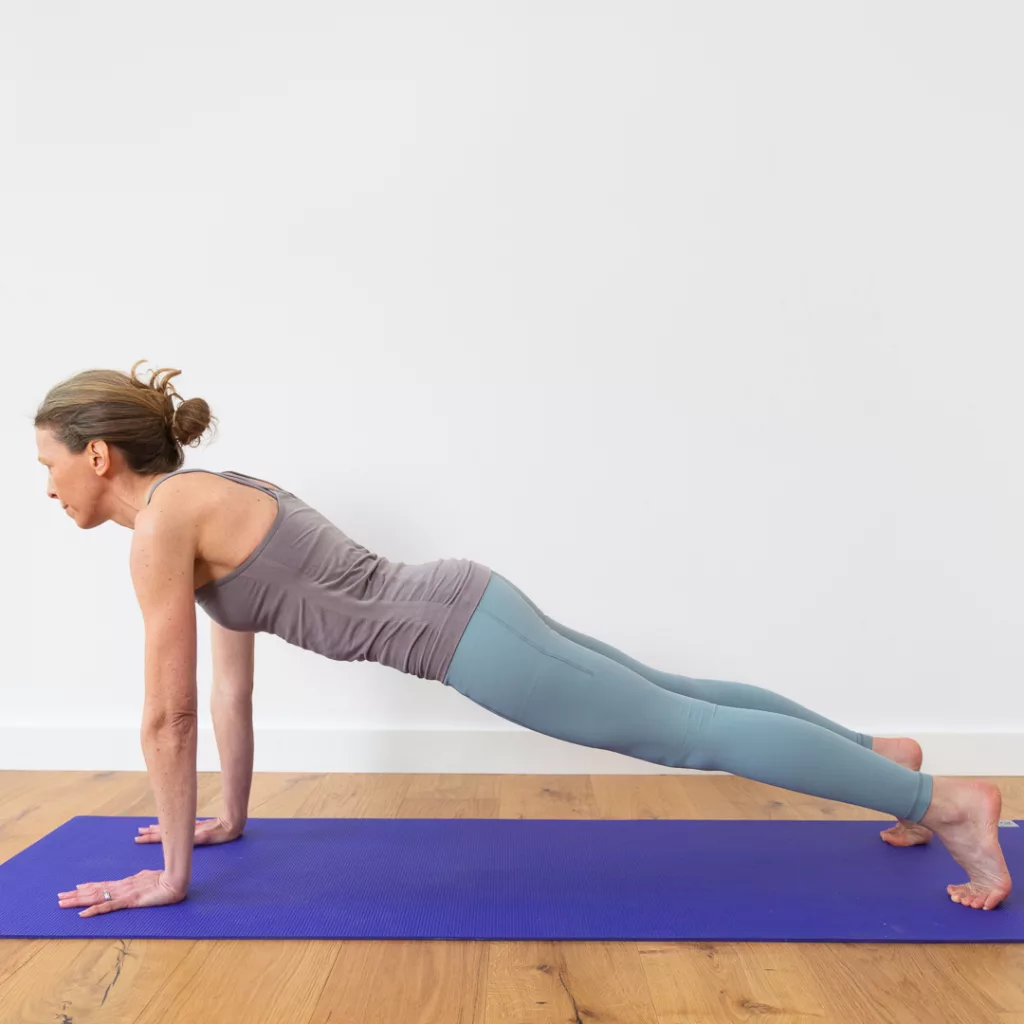
Table of Contents
I’ve always loved to move, and I’m so thankful I love it. I know how hard it is to build it in regularly if you don’t feel the same, and if it’s tied up with what you should do to look a certain way or control things about your body. I exercise because when I do I feel well & I feel strong. At menopause, it’s particularly important to help with symptoms and long-term health and well-being, especially heart, brain, and bone health. I recommend a combination of cardio, strength, restorative movement, and attention to our pelvic floor.
Moving with the menstrual cycle
In terms of movement, hormones impact physiology in so many ways – from metabolism, how well you tolerate heat, reaction time, breathing rates, muscle cell turnover, and more.
When we think of how we may want to move with our cycle there’s no right or wrong way to exercise during your period. Some people will be low on energy and may prefer yoga, and low intensity workouts. Other people may have lots of energy and can really go for it at this time. Paula Radcliffe broke the world record for the marathon while she had menstrual cramps! We know that exercise releases endorphins, which can help with period pain.

In the follicular phase, the first half of the cycle, we tend to be motivated, can adapt well to intense training, build muscle, and recover better. Oestrogen is anabolic, it builds muscle and bone and studies have shown that building in resistance and strength training in the follicular phase can lead to up to 15% more strength gains than spreading that training through the cycle.
Often in the luteal phase, the second half of the cycle, we may have less motivation, and feel more chilled and calm. This can be a great time for slow and steady endurance type of activities. We can sometimes feel more clumsy or uncoordinated at this time.
In the pre-menstrual phase it can be good to build in some feel good energy lifting and anxiety relieving movements, some of us may prefer to dance in the kitchen, and others prefer a restorative yoga session.
What motivates you?
Gretchen Rubin’s book The Four Tendencies is an interesting way to explore motivation by thinking of your personality type. She describes four tendencies of people – upholders, obligers, questioners, and rebels.
For upholders scheduling a run and keeping track of their step count could work brilliantly. Obligers benefit from accountability, and so may find committing to a run with a friend works for them. Questioners need to understand the benefits of exercise and if they accept those they’re likely to do it. And rebels, well they are a law unto themselves and will do it in their own time and in their own way, but definitely not if someone tells them to.
So for any of you who are questioners, at menopause exercise helps our symptoms and our long-term cardiovascular and bone health. In one study of women in their 40s, those with high fitness levels were diagnosed with dementia 9 years later than those with low fitness levels.
Daily habits
Over the years as a GP the most effective ways I’ve seen exercise change people’s lives and health have been when they’ve embraced “active travel” and decided to give up the car and walk or cycle to get around and also when people get a dog, and go for a walk each day. Movement doesn’t have to be runs, sessions in the gym, or long bike rides. Just 10 minutes of walking each day is enough for our brain, to support our mood, creativity, and long-term memory.
Cardio exercise
Cardiovascular exercise is any activity that raises your heart rate for a sustained period of time. Aim for 20 minutes a day or 150 minutes per week. If at perimenopause you’re in sympathetic overdrive feeling stressed and tired then you may benefit more from brisk walking and some weights than an intense HIIT session. So in our 40s, we may need to rethink our movement – what has worked for you to date often stops.
Strength training
Strength training has many benefits at menopause. It reduces fat stores & increases muscle mass, supporting our metabolism. It improves blood pressure, improves immune function, reduces symptoms of hot flushes, helps our mood, and helps us sleep. It increases bone strength, joint strength, and mobility.
A study of over 110 000 people aged 65 to 74 including 70000 women found strength training at least twice a week was associated with a lower mortality from all causes.

So what counts as strength training?
Well basically we need to be working our muscles by pulling or pushing against a force – to grow muscle it needs a stimulus. So this can be done by using your own body weight like doing press-ups against the kitchen counter, it can be by using weights and also with resistance bands. Aim for “high load and low reps” – so it’s better to try a bigger weight and only manage to lift it 3 x than go for an easier one and lift it 10 x. The exception can be if one of your symptoms is joint pain, when you may want to go for a lower weight and more reps. Dr Rangan Chatterjee’s 5 minute kitchen workout can be a great place to start with strength training, no kit or special clothing is needed! Joe Wicks has developed two strength based home exercise routines for menopause too: Strength Workout 1 and Strength Workout 2.
Pelvic floor health
If the thought of jumping around and lifting heavy weights has you crossing your legs and worrying about your pelvic floor you might want to consider a pelvic physio assessment first. They are incredibly knowledgeable and can help you assess what types of exercises will benefit you and your pelvic floor, how to use your breath, and if there’s anything that may be best to avoid at the moment. There’s no one size fits all for pelvic floor exercises, some of us will need to strengthen, and some will need to focus more on relaxation so specialist help can be really useful here.
Why do I recommend restorative movement?

Many people I see at mid-life feel overwhelmed, and are living day to day in a fight or flight sympathetic nervous system state. Rest can be a really key part of the jigsaw to consider when we are looking to support both our day to day symptoms and our long-term health and wellbeing. It can be hard to schedule time for rest, but sometimes easier to prioritise time for a yoga or pilates class. Yoga and pilates can build a lot of strength, but often will also encourage us to tune in, to be, to notice our breath, and this can be very powerful.
More resources
Stacy Sims’ book Next Level
Jennis app tailoring movement with menstrual cycles and at perimenopause
